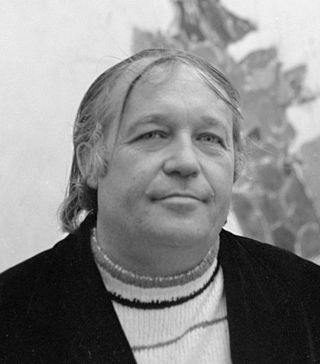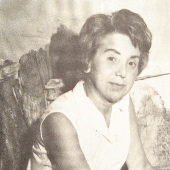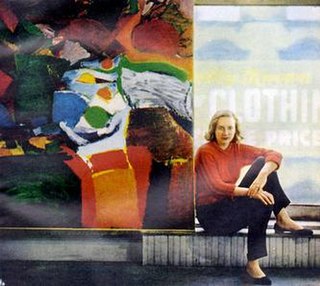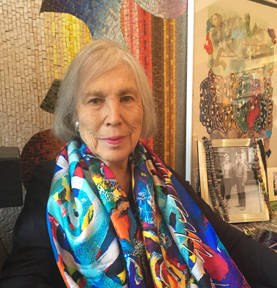Related Research Articles
Abstract expressionism is a post–World War II art movement in American painting, developed in New York City in the 1940s. It was the first specifically American movement to achieve international influence and put New York at the center of the Western art world, a role formerly filled by Paris.

Helen Frankenthaler was an American abstract expressionist painter. She was a major contributor to the history of postwar American painting. Having exhibited her work for over six decades, she spanned several generations of abstract painters while continuing to produce vital and ever-changing new work. Frankenthaler began exhibiting her large-scale abstract expressionist paintings in contemporary museums and galleries in the early 1950s. She was included in the 1964 Post-Painterly Abstraction exhibition curated by Clement Greenberg that introduced a newer generation of abstract painting that came to be known as color field. Born in Manhattan, she was influenced by Greenberg, Hans Hofmann, and Jackson Pollock's paintings. Her work has been the subject of several retrospective exhibitions, including a 1989 retrospective at the Museum of Modern Art in New York City, and been exhibited worldwide since the 1950s. In 2001, she was awarded the National Medal of Arts.

Samuel Lewis Francis was an American painter and printmaker.

Lenore "Lee" Krasner was an American abstract expressionist painter, with a strong speciality in collage. She was married to Jackson Pollock. Although there was much cross-pollination between their two styles, the relationship somewhat overshadowed her contribution for some time. Krasner's training, influenced by George Bridgman and Hans Hofmann, was the more formalized, especially in the depiction of human anatomy, and this enriched Pollock's more intuitive and unstructured output.

Richard Diebenkorn was an American painter and printmaker. His early work is associated with abstract expressionism and the Bay Area Figurative Movement of the 1950s and 1960s. In the late 1960s he began his extensive series of geometric, lyrical abstract paintings. Known as the Ocean Park paintings, these paintings were instrumental to his achievement of worldwide acclaim.

Elaine Marie Catherine de Kooning was an Abstract Expressionist and Figurative Expressionist painter in the post-World War II era. She wrote extensively on the art of the period and was an editorial associate for Art News magazine.

Color field painting is a style of abstract painting that emerged in New York City during the 1940s and 1950s. It was inspired by European modernism and closely related to abstract expressionism, while many of its notable early proponents were among the pioneering abstract expressionists. Color field is characterized primarily by large fields of flat, solid color spread across or stained into the canvas creating areas of unbroken surface and a flat picture plane. The movement places less emphasis on gesture, brushstrokes and action in favor of an overall consistency of form and process. In color field painting "color is freed from objective context and becomes the subject in itself."

Amy Sillman is a New York-based visual artist, known for process-based paintings that move between abstraction and figuration, and engage nontraditional media including animation, zines and installation. Her work draws upon art historical tropes, particularly postwar American gestural painting, as both influences and foils; she engages feminist critiques of the discourses of mastery, genius and power in order to introduce qualities such as humor, awkwardness, self-deprecation, affect and doubt into her practice. Profiles in The New York Times, ARTnews, Frieze, and Interview, characterize Sillman as championing "the relevance of painting" and "a reinvigorated mode of abstraction reclaiming the potency of active brushwork and visible gestures." Critic Phyllis Tuchman described Sillman as "an inventive abstractionist" whose "messy, multivalent, lively" art "reframes long-held notions regarding the look and emotional character of abstraction."

Jane Schenthal Frank was an American multidisciplinary artist, known as a painter, sculptor, mixed media artist, illustrator, and textile artist. Her landscape-like, mixed-media abstract paintings are included in public collections, including those of the Corcoran Gallery of Art, the Baltimore Museum of Art, and the Smithsonian American Art Museum. She studied with artists, Hans Hofmann and Norman Carlberg.

Joan Mitchell was an American artist who worked primarily in painting and printmaking, and also used pastel and made other works on paper. She was an active participant in the New York School of artists in the 1950s. A native of Chicago, she is associated with the American abstract expressionist movement, even though she lived in France for much of her career.

John Hamilton Bush was a Canadian abstract painter. A member of Painters Eleven, his paintings are associated with the Color Field movement and Post-painterly Abstraction. Inspired by Henri Matisse and American abstract expressionist painters like Helen Frankenthaler and Morris Louis, Bush encapsulated joyful yet emotional feelings in his vibrant paintings, comparing them to jazz music. Clement Greenberg described him as a "supreme colorist", along with Kenneth Noland in 1984.

Shirley Jaffe was an American abstract painter. Her early work is of the gestural abstract expressionist style, however in the late 1960s she changed to a more geometric style. This change was initially received with caution by the art world, but later in her career she was praised for the "idiosyncratic" and individual nature of her work. She spent most of her life living and working in France.
Michael Goldberg was an American abstract expressionist painter and teacher known for his gestural action paintings, abstractions and still-life paintings. A retrospective show, "Abstraction Over Time: The Paintings of Michael Goldberg", was shown at MOCA Jacksonville in Florida from 9/21/13 to 1/5/14. His work was seen in September 2007 in a solo exhibition at Knoedler & Company in New York City, as well as several exhibitions at Manny Silverman Gallery in Los Angeles. Additionally, a survey of Goldberg's work is exhibited at the University Art Museum at California State University, Long Beach since September 2010.
Alfred Julio Jensen was an abstract painter. His paintings are often characterized by grids of brightly colored triangles, circles or squares, painted in thick impasto. Conveying a complex web of ideas, often incorporating calligraphy or numerical systems, they are frequently referred to as "concrete" abstract art. After his death in 1981, the Guggenheim organized a major retrospective of his work, having held his solo exhibition there in 1961.

20th-century Western painting begins with the heritage of late-19th-century painters Vincent van Gogh, Paul Cézanne, Paul Gauguin, Georges Seurat, Henri de Toulouse-Lautrec, and others who were essential for the development of modern art. At the beginning of the 20th century, Henri Matisse and several other young artists including the pre-cubist Georges Braque, André Derain, Raoul Dufy and Maurice de Vlaminck, revolutionized the Paris art world with "wild", multi-colored, expressive landscapes and figure paintings that the critics called Fauvism. Matisse's second version of The Dance signified a key point in his career and in the development of modern painting. It reflected Matisse's incipient fascination with primitive art: the intense warm color of the figures against the cool blue-green background and the rhythmical succession of the dancing nudes convey the feelings of emotional liberation and hedonism.

Grace Hartigan was an American Abstract Expressionist painter and a significant member of the vibrant New York School of the 1950s and 1960s. Her circle of friends, who frequently inspired one another in their artistic endeavors, included Jackson Pollock, Larry Rivers, Helen Frankenthaler, Willem and Elaine de Kooning and Frank O'Hara. Her paintings are held by numerous major institutions, including the Museum of Modern Art in New York City. As director of the Maryland Institute College of Art's Hoffberger School of Painting, she influenced numerous young artists.

Amaranth Roslyn Ehrenhalt was an American painter, sculptor, and writer, who spent the majority of her career living and working in Paris, France before returning to New York City.
La Vie en Rose is a "quadtych", a four panel oil on canvas work by the New York School abstract expressionist painter Joan Mitchell, created in 1979. Named after the 1940s signature song by the French chanteuse Edith Piaf it is in the permanent collection of the Metropolitan Museum of Art, in New York. The work is possessed of black, lavender, pink, and gray passages.
Salut Tom is a 1979 oil on canvas quadtych painting by Joan Mitchell, dedicated to the memory of her friend, art critic and curator Thomas B. Hess, who had died the previous year. The work is in the permanent collection of the National Gallery of Art in Washington DC and entered the museum as part of the collection the national Gallery was given by the board of the Corcoran Gallery when that art institution closed in 2014.
Sans Neige is a 1969 oil on canvas triptych painting by the American New York School abstract expressionist artist Joan Mitchell. It is in the permanent collection of the Carnegie Museum of Art in Pittsburgh.
References
- ↑ "The intense life of abstract expressionist Joan Mitchell". www.cbsnews.com.
- ↑ "Joan Mitchell's Resplendent Paintings: How the Abstract Expressionist Resolved the Unresolvable". September 1, 2021.
- ↑ Cascone, Sarah (September 20, 2021). "'We Wanted to Unmoor Her From the 1950s': A Joan Mitchell Retrospective at SFMOMA Shows the Artist as You've Never Seen Her Before". Artnet News.
- ↑ Abraham, Sarah (June 26, 2022). "Joan Mitchell: landscapes absorbed". Vin de Vie Wine of Life.
- ↑ "Figure and the City". Joan Mitchell Foundation.